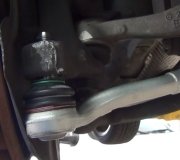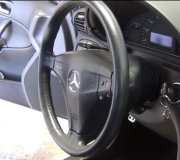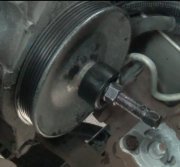There's two different suspension systems for the Thunderbird. If your ball joints are built as part of the control arms, you had to replace the complete assemblies. That means rubber bushings were involved. The most common mistake is tightening those bolts while the car is still raised off the ground and the wheels are removed. That clamps the bushings in that orientation, then, when you lower it onto the tires and it's sitting at proper ride height, those bushings will be in a permanent twist. That will reduce their life to about 10 percent of normal.
The second problem, due to the environment those parts live in, is rust forms on the bolt threads. If that gets real bad, the bolts get rusted to the inner sleeves of the bushings and you may have to cut them off and replace them. Before they get that bad you may be able to remove and reuse them, but that rust in the threads can cause the nuts to appear to be tight before they exert sufficient clamping force. The car must be bounced on the ground a few times or driven around the parking lot with those bolts still loose, then they are tightened while the car is sitting at rest. That adds to the rust-in-the-threads problem because you can't get much leverage when reaching over the tops of a tires. The result is a bolt you think feels tight when in fact it's loose.
When replacing any tie rod end, or any ball joint that is part of a control arm, the car must be aligned. The mechanic should have noticed the squeaking on the test drive after the alignment. Squeaks and rattles should never be ignored on any car, but that is especially important on Ford products. They have way more trouble with steering and suspension parts separating leading to loss of control and crashes than all other manufacturers combined. Usually the culprit is the lower, load-carrying ball joint, so I'm relieved you replaced them. That leaves your squeak the result of something that's just annoying, and not dangerous.
It is also customary to use grease on the control arm bolts to prevent future rust buildup but you need to be careful to not get it on the rubber parts of the bushings. Petroleum-based products can rot the rubber. I like "White Spray Lube" which happens to be a Chrysler product that I'm familiar with, but the same stuff is available from all manufacturers and auto parts stores. I spray it on the bolt threads before I stuff them into the bushings so no over-spray gets on the rubber.
There is a tool you might be able to borrow or rent from an auto parts store that borrows them called the "Chassis Ear". It is a set of six microphones, a switch box, and headphones. You clip the microphones to suspect points, then drive around while listening with the headphones. You can move the microphones around to zero in on the source of the noise. Be aware that many mechanics have never seen or even heard of this tool. Suspension and alignment mechanics use it to find rattles, squeaks, and other noises.
An unusual place I've found a squeak after service to a strut suspension system is a rock stuck between the bottom of the coil spring and the mounting plate on the strut. Those small pebbles lay inside the bottom coil, then drop down and get wedged in there when the car is jacked up and tension is off the spring.
Also look at the nut that holds the anti-sway bar to the lower control arm to be sure rust in the threads didn't prevent one from being fully tightened. That bar actually goes into a twist just from turning to one side, even when the car is standing still. The amount of twist increases from body roll when the car is moving. That extends the bushing's range of travel and being loose or being clamped in the wrong orientation can lead to an elusive squeak. The inner anti-sway bar bushings can squeak too, and that can first show up after other service from it being turned further than normal in those bushings when the suspension is hanging. People have been known to complain of squeaks after things like a routine oil change. The cause is those bushings but the problem didn't show up until something was done that allowed the suspension to hang. For that reason, you may find the cause of your squeak to be something you didn't do anything to.
Monday, November 11th, 2013 AT 2:23 PM



